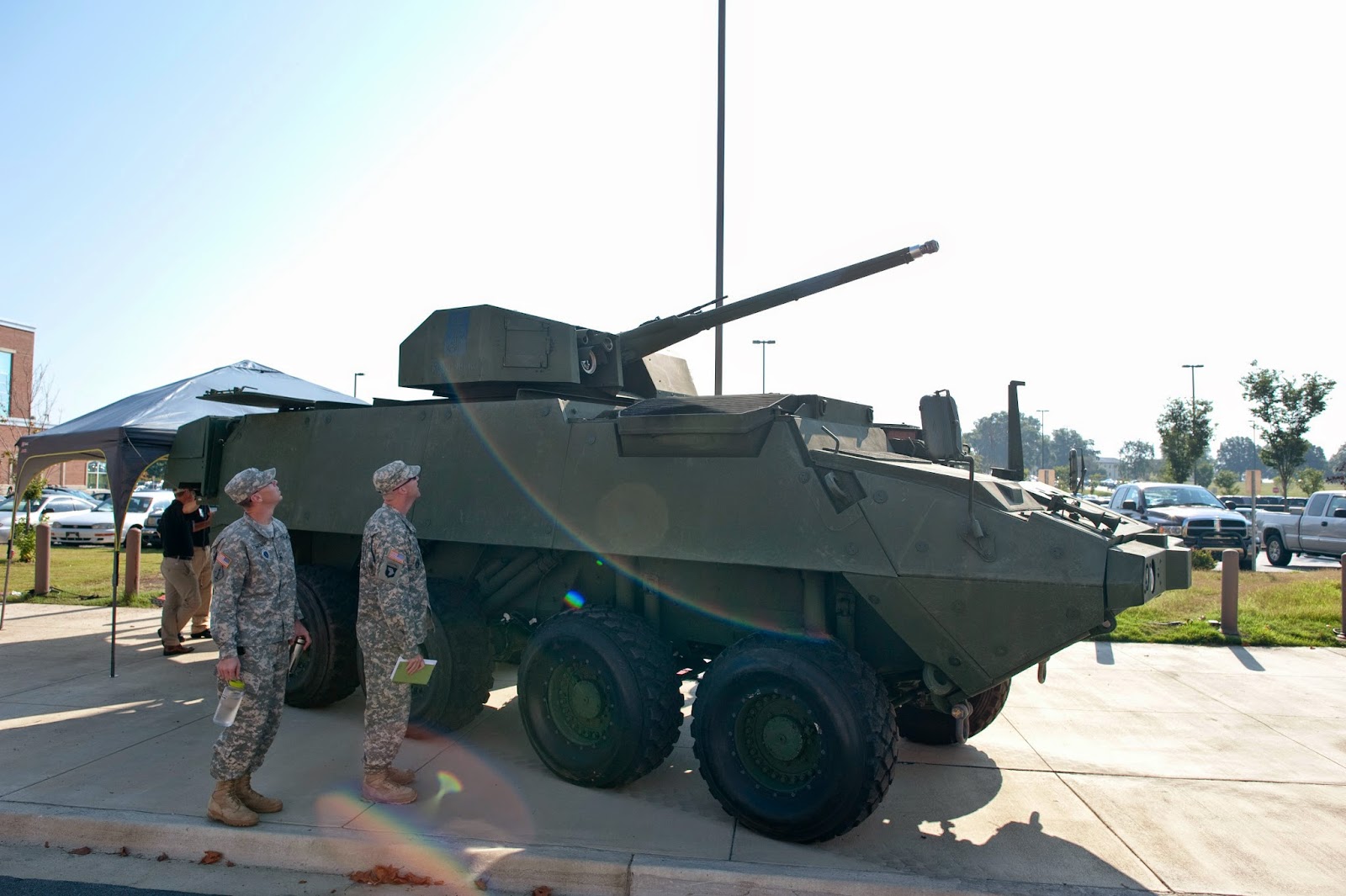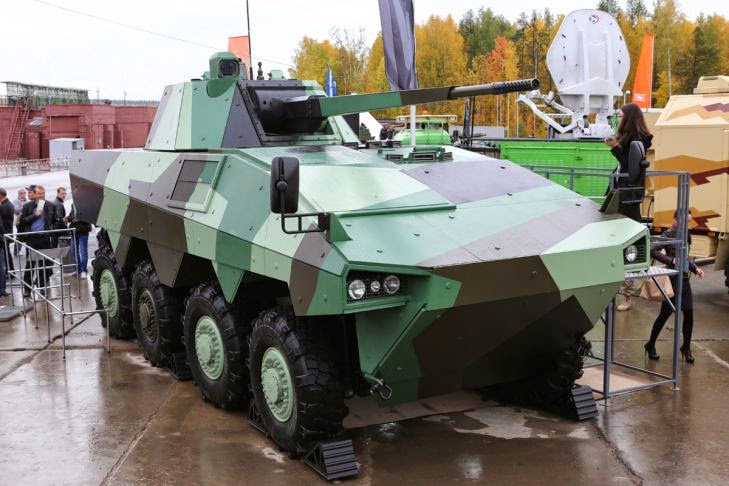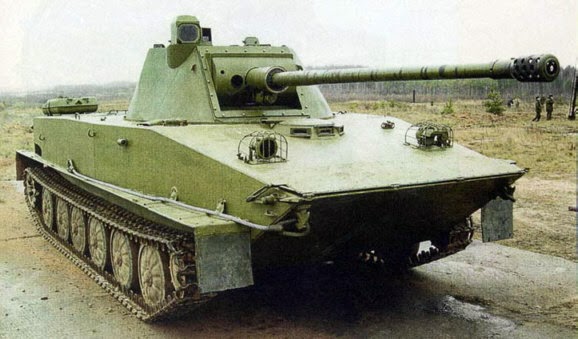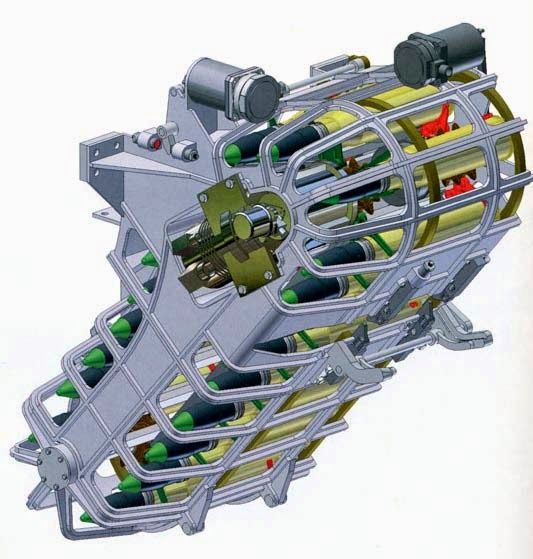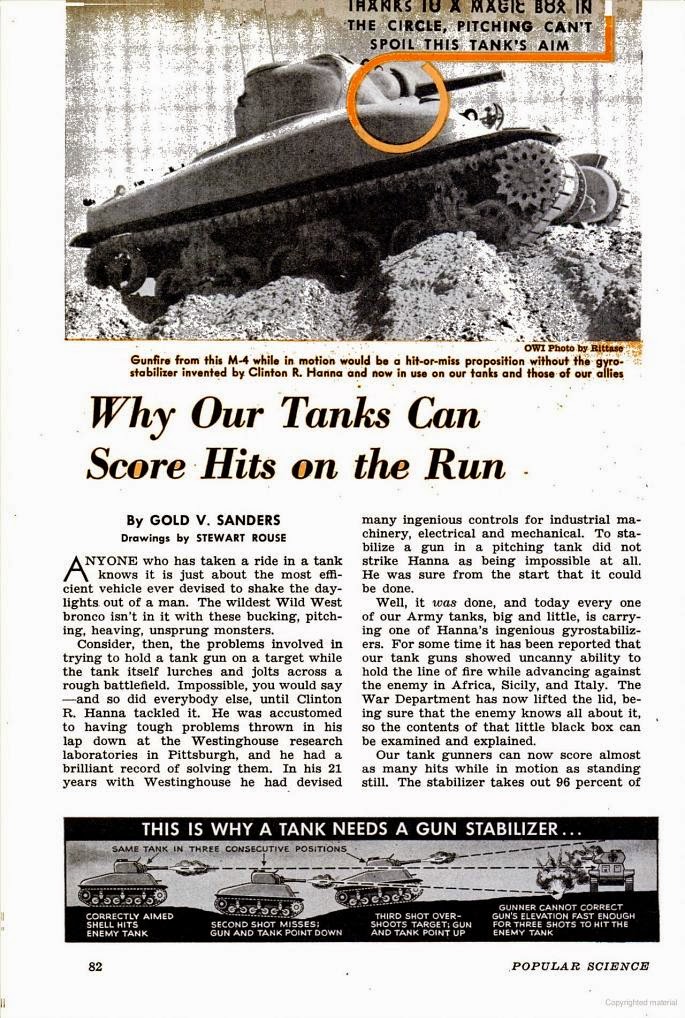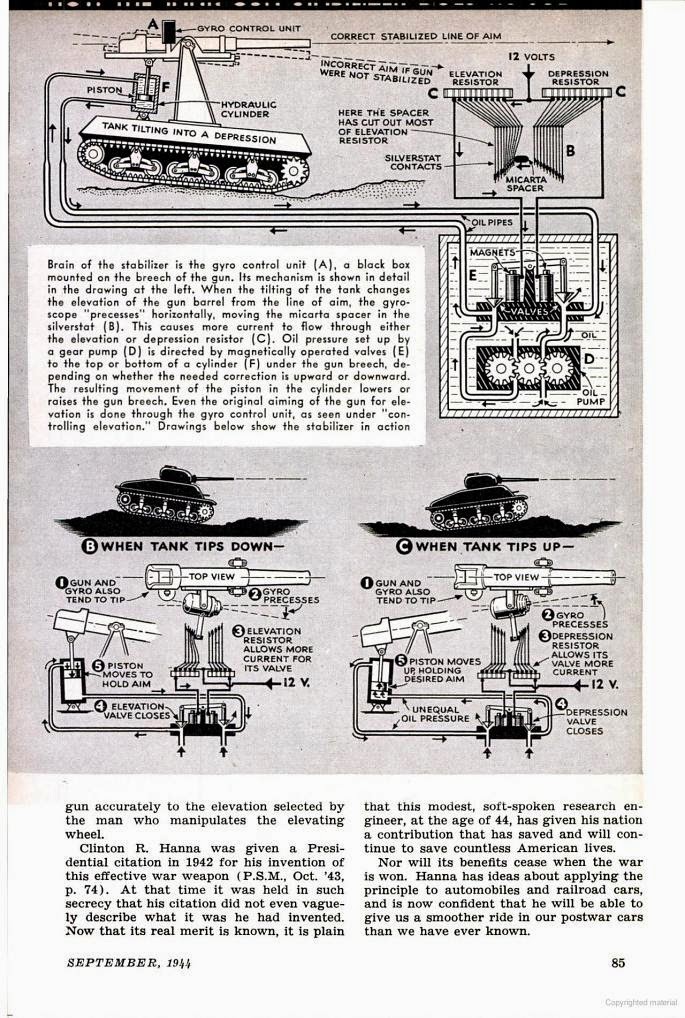↧
Eurosatory 2014
↧
Eurosatory 2014 Post 2
MCT-30 Protector Medium Caliber Turret
Kongsberg's MCT30 remote turret is being exhibited in General Dynamics Booth on a LAV 8x8 vehicle.
The turret is remotely operated under armor. It has got an ATK Mk44 30mm automatic cannon and a co-axial 7.62mm machine gun located to the top and left side of the main gun.
The main gun is fed from a Linkless Feed System from Meggitt. The system comprises of two lammo cans on either side of the main gun with 75 rounds each with a total ready to fire ammo capacity of 150 rounds.
The reloading is performed under armor.
The turret has a pan-tilt style independent sight from CarlZeiss with thermal imager, day camera and LRF.
Turret moves from -10 deg to +45deg in elevation.
The brochure states that the main gun has First-Round-Select capability which indicates they have the stretched version of the Mk44 with closed bolt firing.
↧
↧
Eurosatory Post IV
↧
Eurosatory 2014 Post 5
↧
Eurosatory 2014 Post 3
↧
↧
Eurosatory 2014
IMI's COMBAT GUARD 4x4
The Show's new boy is definitely Combat Guard. The vehicle was announced some weeks ago with a striking video and has been the topic of discussion since.
My first impression was "this is a big boy!.." The vehicle is quite large for a 4x4. Most of the height is coming from its very high ground clearance.
Its got solid axles rear and front and very large tyres.
↧
Eurosatory 2014
The 7.62mm Chaingun from now on to be known as Mk52.
I have posted a detailed article on the 7.62mm ChainGun:(http://warfaretech.blogspot.fr/2014/02/762mm-chaingun-from-atk.html)
I found the opportunity to see the weapon first hand.
The gun is even more compact than Ive seen from its photos.
The empty cases are ejected from the front of the barrel. This eliminates an important complexity for turret integration.
The gun does not need a mount in the conventional sense. The clamp to the front reciever is the mount. There goes another complexity for turret integration. It does not require a complex, machined mount with a high manufacturing cost. I dont even consider the weight of the conventional mount.
The barrel can be changed from inside the turret by lowering the bottom part of the reciever thru its hinge.
If ATK can drop the price of the gun to a lower level, I believe we are looking at a must have equipment for a turret or RWS.
↧
Eurosatory 2014
↧
Eurosatory 2014
↧
↧
Eurosatory 2014
↧
Eurosatory 2014
↧
Eurosatory 2014
CMI's CPWS Remote Turret
CMI has developed an unmanned turret called CPWS that can be equipped with medium caliber weapons from 20mm to 30mm caliber.
The turret has got a single panoramic sight that is used for both surveillance and engagement. Sight is two axis stabilzed with TI, Day. Camera and LRF.
The remote turret has access from the vehicle thru a hatch under the turret.
The turret has an elevation range of from -10 deg to +45degrees.
Different ballistic protection levels are offered up to STANAG 4569 LvL 4 with modular armor packages.
Although they say "the turret is light weight" I was unable to find any numerical data in their brochure.
I saw 3 CPWS remote turrets on Renault VAB, Panhard Crab and a Ukranian BTR4.
↧
Eurosatory 2014
Oerlikon Revolver Gun Mk2
In rheinmetall's booth, they have the latest version of the unmanned Air and Counter Artillery & Mortar turret with Revolver Cannon Mk2 35mm.
You can find more information on Revolver Cannon technology from my website using the link below:
↧
↧
30mm Cannon vs 12.7mm Machinegun
US Army's "comparative" trials of
Firepower for Strykers:
30mm Autocannon
vs
12.7mm Machinegun
US Army's Stryker 8x8's has been armed with a remote weapon station (RWS) with a .50cal (12.7mm) M2 machinegun.
Sometime ago I've heard that US Army is considering up-arming the Strykers, or at least a portion of the fleet, with a weapon system that has more bite than the .50cal.
The turret that has been selected for consideration is the Kongsberg's 30mm Remote Turret MCT30 armed with 30mm Mk44 and a 7.62mm machinegun as coax.
The following YouTube video is an excerpt from this effort.
However, it is a little bit funny to even demonstrate the capabilities of such diversely different weapons as the .50cal and 30mm.
I won't even go to the details like muzzle energy or penetration and just will post the image below. One image is worth thousand words as they say...
Here is an image with the Kongsberg turret on Styker:
Here is the video I've mentioned:
As the soldier in the video says:
"Don't bring a knife to a gunfight. That's kind of what this is... Give me a 30mm to fight and it's over!"
↧
57mm Autocannon Turret from Russia
Russian 57mm AutoCannon Turret:
The Future Caliber or Relic from the Past?
The Franco-Russian cooperation for an IFV was recently revealed. It's an 8x8 vehicle called Atom.
One of the features that got quite a bit of attention is the 57mm main gun in the two-men turret.
The turret is called AU-220. It's been initially developed as an upgrade to the PT-76 amphibious tank to replace its 76mm main gun and old turret.
An upgraded PT-76 is shown with the 57mm AU-220 turret.
57mm Gun
The 57mm gun that's also used in Atom 8x8 is basically an Anti-Aircraft gun used in S-60 towed AA system. The gun was developed in 1950's.
In the AA configuration the gun is fed by 4 round clips. The same gun in the S60 AA mount is shown below.
The same cannon also used in ZSU-57-2 SPAAG vehicle.
The cannon uses 57x347mm semi-rimmed ammunition. The image below shows the 57mm ammunition vs the Bofors 40x365 ammunition.
The gun is recoil operated. Rate of fire is 105-120 rpm and the muzzle velocity is around 1.020 m/sec. It has a barrel length of around 4.4m.
The effective firing range against ground targets is 4km's.
AU-220 Turret
The turret is of Two Men configuration and weighs around 3.5 tons. The main armament is the 57mm rapid fire cannon.
The gun has a new automatic loading capable ammunition feed system that houses 20 ready-to-fire rounds as shown below.
The turret basket has a powered 73 round ammunition carousel that provides ammunition to the linkless feeder above.
The 57mm gun with the AP round has a penetration capability of 130mm of Steel at a range of 1.000m. I would expect the penetration would be much better for the huge 57mm caliber.
The 35mm APFSDS round has 120mm penetration at the same range.
This does not mean a lot at first glance, and you can think that the 57mm is still better than 35mm.
But when you think about the 35mm round doing all this with only 22% of the mass of the 57mm, one thinks that the 57mm caliber needs new ammunition in the APFSDS type to become a serious contender in the medium caliber market.
©WarfareTechnology 2014
↧
Lockheed's Brand New 30mm Two-Men and Hellfire Turrets for Qatar
Lockheed's Brand New
30mm 2-Men IFV
&
Dedicated Hellfire (LRSAV) Turrets
Aimed for Qatar
&
Dedicated Hellfire (LRSAV) Turrets
Aimed for Qatar
I've got some more information the turret's potential customer. It is most probably for Qatar Armed Forces. The turret has been specifically designed for Qatar for a possible number of 200+ turrets.
Also Lockheed has been working on a dedicated Hellfire and DAGR missile turret which is probably also aimed for Qatar for Artillery Corps.
The video below shows a test fire of the Hellfire ATGM from the ATGM turret defining a system called Long Range Surveillance & Attack Vehicle dubbed LRSAV.
Rumor's have been circulating around for sometime that Lockheed Martin UK has been working on a new Two-Men IFV turret with ATK 30mm Bushmaster gun as the main armament.
This video released on July 10th from Lockheed Martin explains:
The most interesting thing in the video beside the turret is the vehicle being a Boxer 8x8.
We have accustomed to seeing Boxer armed with either Rheinmetall's Lance Two-Men Turret or even Spz Puma's remote turret.
However, there are also rumors circulating that this Lockheed turret is specifically developed to be offered to a undisclosed Middle East customer on Boxer 8x8.
We know that Boxer has participated UAE's yearly Summer trials before and offered to UAE for their 4-5 year long 8x8 acquisition programme.
However another country that comes to mind is Qatar which also is evaluating 8x8 vehicles for their 8x8 acquisition programme.
I would bet on Qatar for the possible customer this brand new turret from Lockheed on Boxer.
Time will tell....
↧
Gun Stabilization as Explained in 1944
Gun Stabilization
as explained in
September 1944
edition of
Popular Science
Quite an interesting article from September 1944 issue of the Popular Science magazine.
It explains in great detail how the gun stabilization is performed in US tanks in 2nd World War.
The brains behind the gyro stabilization was Clinton R. Hanna from Westinghouse.
Read the rest of this interesting article below:
Resources:
- G. V. Sanders, Popular Science, Sept. 1944. via Google Books.
↧
↧
I can see future 4x4s with these tyres
↧
Textron's Scorpion and its record development timeframe
Scorpion Attack Aircraft from Textron:
The plane that caught World War II Development Timeframe
The Scorpion Attack Aircraft might be a very good versatile aircraft or it may not...
However I am not to discuss the aircraft specifics, rather the time it took the develop the plane. Two and a half years ago Scorpion was just a concept on a PowerPoint slide . But in July this year, it flew from Kansas to Hampshire in UK for the Farnborough Airshow.
It is quite impressive given the time it takes to develop modern aircraft these days...
Look at F35: Development Contract signed Nov. 1996, System Development & Demonstration on 2001. First Flight 2006. It's already 2014 and the plane still not fully in service.
F15 Eagle: First Flight in 1972, entered service 1976.
Fast Rewind >> 1930s. Lockheed awarded contract for P38 June 1937. First Flight January 1939. Total time from Contract to First Flight 18 Months!
The tools and technology that helps engineers advances vastly. In 1930s there wasnt even a calculator, only drawing boards and slide rulers. Now we have Computer Aided Design tools, Product Lifecycle Management Tools, Computer Aided Analysis Tools, FEA, Computational Fluid Dynamics, even software that analyzes ans simulates Radar Cross-sections. Computational capabilities are multiplying
Yet the development durations are increasing dramatically in spite of all the tools and computational capabilities...
↧
DARPA's EXACTO Programme
DARPA's EXACTO Programme aims at:
Guided 12.7mm/.50cal Rounds
DARPA’s Extreme Accuracy Tasked Ordnance (EXACTO) program recently conducted the first successful live-fire tests demonstrating in-flight guidance of .50-caliber bullets. EXACTO’s specially designed ammunition and real-time optical guidance system help track and direct projectiles to their targets by compensating for weather, wind, target movement and other factors that could impede successful hits.
The EXACTO program is developing new approaches and advanced capabilities to improve the range and accuracy of sniper systems beyond the current state of the art.
The bullets independently maneuver through the air after being fired and they successfully hit targets that were over a mile away.
The rounds changed their path in-flight, striking targets that were not lined up with the sniper rifles' original aim. The .50 caliber rounds utilize optical sighting technology and a real-time guidance system, allowing them to be used anytime during the day and night.
DARPA explains the importance of the bullets noting, "It is critical that snipers be able to engage targets faster, and with better accuracy, since any shot that doesn't hit a target also risks the safety of troops by indicating their presence and potentially exposing their location."
The ammunition will also be extremely helpful when windy weather or moving targets make accurate shots far more difficult. The entire system is still in the prototype stage and will need to be further tested, but the smart rounds certainly have the potential to revolutionize rifle precision.
The bullets independently maneuver through the air after being fired and they successfully hit targets that were over a mile away.
The rounds changed their path in-flight, striking targets that were not lined up with the sniper rifles' original aim. The .50 caliber rounds utilize optical sighting technology and a real-time guidance system, allowing them to be used anytime during the day and night.
DARPA explains the importance of the bullets noting, "It is critical that snipers be able to engage targets faster, and with better accuracy, since any shot that doesn't hit a target also risks the safety of troops by indicating their presence and potentially exposing their location."
The ammunition will also be extremely helpful when windy weather or moving targets make accurate shots far more difficult. The entire system is still in the prototype stage and will need to be further tested, but the smart rounds certainly have the potential to revolutionize rifle precision.
↧



















































